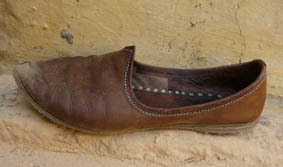 In rural Rajasthan jootis are obligatory. Traditional, hardwearing pointed shoes made from either camel or cow leather that stretch over time providing a perfect fit for the wearer. They are usually worn by men, whilst women tend to stick to rubber flip flops. Often a pair of well-made jootis will last two years with daily use.
In rural Rajasthan jootis are obligatory. Traditional, hardwearing pointed shoes made from either camel or cow leather that stretch over time providing a perfect fit for the wearer. They are usually worn by men, whilst women tend to stick to rubber flip flops. Often a pair of well-made jootis will last two years with daily use.The first pair I bought weren't well made, they were tourist tat from Pushkar and although ridiculously comfortable, after three weeks they'd developed large holes on both soles and the upper stitched was coming apart. Wear flip flops every day in India at your peril- heels quickly become cracked from the dust exposure and require a regular care plan using a soft brush, pumice and monthly trips to the beauty parlour who grate the fine pieces of dead skin off. Not pleasant I know, but very neccessary. I was keen to find some appropriate heel protecting footwear that would last longer than a month and my disintergrating jootis quickly became a talking point as I shared my predicament.
With help from my Indian father I discovered that almost all the men living in my household purchase their jootis from a village 6 kms away where they are handmade and of a very high quality, with the sole consisting of a single piece of thick leather. Dasrat. the office boy took me through the desert on the 'official' motorbike (everything related to work is official here) and in the middle of a group of mud and clay houses was our target. Three men sitting outside with a few scraps of leather and some metal tools. Embarrassed, I showed them the offending jootis, they casually measured my feet and, repeatedly emphasised how wide they are, I chose the leather colour and basic style and two days later went to pick them up.
Another 30 minutes on the bike along dusty tracks to nowhere, 350 rupees were exchanged (£4.50) and I went away with my very own made-to-measure shoes which remarkably fitted perfectly. All the men folk were mighty impressed as we compared jootis and discussed sole material, colour, price, stitching, durability and how long it would take until they softened and moulded to my feet. In fact, that afternoon, initiated by Dasrat we held a small, intimate jooti party in the office to celebrate their arrival. Chai was served and numkeen (basically bombay mix) flowed.
 I had been instructed to give my new item of footwear an oil massage 10 days after purchasing and now they've turned a rich tertiary colour but seem to have become tighter. I'm persevering, determined that they will last the 8 months until the end of my placement. After last night when Grandma looked disapprovingly at my feet I'll have to be careful not to wear them whilst eating. Apparently leather isn't allowed, I have to change into flip flops, or slippers as they're called here. I asked what would happen if we were eating non-veg (which we very rarely do but I thought it was an interesting idea, to be eating meat but not allowed to wear animal skin shoes). My boss said when eating non veg anything goes!
I had been instructed to give my new item of footwear an oil massage 10 days after purchasing and now they've turned a rich tertiary colour but seem to have become tighter. I'm persevering, determined that they will last the 8 months until the end of my placement. After last night when Grandma looked disapprovingly at my feet I'll have to be careful not to wear them whilst eating. Apparently leather isn't allowed, I have to change into flip flops, or slippers as they're called here. I asked what would happen if we were eating non-veg (which we very rarely do but I thought it was an interesting idea, to be eating meat but not allowed to wear animal skin shoes). My boss said when eating non veg anything goes!
nice artice.. thanks for you sharing from this
ReplyDeletejootis article